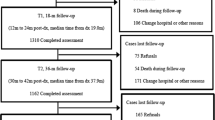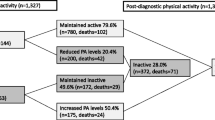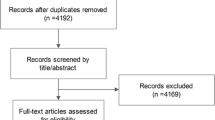Abstract
Purpose of Review
Breast cancer (BC) recurrence dramatically decreases 5-year survival, which causes a fear of BC recurrence among a majority of BC survivors. Evidence is currently inconsistent on whether post-diagnosis recreational physical activity (rPA) can prevent BC recurrence due to the small number of included studies, as well as methodological heterogeneity among the studies. This systematic review aimed to clarify the association between post-diagnosis rPA and the risk of BC recurrence, by conducting a meta-analysis while controlling for the categories of rPA across the existing studies.
Recent Findings
Prospective cohort studies were searched, and five studies were eligible for the meta-analysis. Of 10,094 patients with BC, 1561 had recurrence during the follow-up period ranging from 12 to 156 months. The meta-analysis revealed that patients whose post-diagnosis rPA was ≥ 7.5 metabolic equivalents (MET-h/week) had a lower BC risk than patients whose rPA was 0–3 MET-h/week (hazard ratio [HR], 0.65; 95% CI, 0.58–0.73, p < 0.00001, I2 = 0%).
Summary
The review indicated that a post-diagnosis rPA of ≥ 7.5 MET-h/week could reduce the risk of BC recurrence by 35%. Although it is necessary to investigate randomized controlled studies in the future, this result will strengthen strategies for the care and/or treatment of patients after BC and can motivate BC survivors to participate in rPA programs after BC diagnosis.





Similar content being viewed by others
Data Availability
The data that supports the findings of this study are available in the supplementary material of this article.
References
Papers of particular interest, published recently, have been highlighted as: • Of importance •• Of major importance
Siegel RL, Miller KD, Fuchs HE, Jemal A. Cancer statistics, 2022. CA Cancer J Clin. 2022;72(1):7–33. https://doi.org/10.3322/caac.21708.
Sung H, Ferlay J, Siegel RL, Laversanne M, Soerjomataram I, Jemal A, et al. Global cancer statistics 2020: GLOBOCAN estimates of incidence and mortality worldwide for 36 cancers in 185 countries. CA Cancer J Clin. 2021;71(3):209–49. https://doi.org/10.3322/caac.21660.
Early Breast Cancer Trialists’, Peto R, Davies C, Godwin J, Gray R, Pan HC, et al. Comparisons between different polychemotherapy regimens for early breast cancer: meta-analyses of long-term outcome among 100,000 women in 123 randomised trials. Lancet. 2012;379(9814):432–44. https://doi.org/10.1016/S0140-6736(11)61625-5.
Perez EA, Romond EH, Suman VJ, Jeong JH, Davidson NE, Geyer CE Jr, et al. Four-year follow-up of trastuzumab plus adjuvant chemotherapy for operable human epidermal growth factor receptor 2-positive breast cancer: joint analysis of data from NCCTG N9831 and NSABP B-31. J Clin Oncol. 2011;29(25):3366–73. https://doi.org/10.1200/JCO.2011.35.0868.
• Nakano M, Fujisue M, Tashima R, Okumura Y, Nishiyama Y, Ohsako T, et al. Survival time according to the year of recurrence and subtype in recurrent breast cancer. Breast. 2015;24(5):588–93. https://doi.org/10.1016/j.breast.2015.06.003. This study demonstrated that the relationship between breat cancer recurrence and survival rate.
• Koch L, Bertram H, Eberle A, Holleczek B, Schmid-Hopfner S, Waldmann A, et al. Fear of recurrence in long-term breast cancer survivors-still an issue. Results on prevalence, determinants, and the association with quality of life and depression from the cancer survivorship—a multi-regional population-based study. Psychooncology. 2014;23(5):547–54. https://doi.org/10.1002/pon.3452. This study shows that fear of recurrence is highly prevalent among breast cancer survivors and can negatively affect well-being.
Dieterich M, Stubert J, Reimer T, Erickson N, Berling A. Influence of lifestyle factors on breast cancer risk. Breast Care (Basel). 2014;9(6):407–14. https://doi.org/10.1159/000369571.
•• Spei ME, Samoli E, Bravi F, La Vecchia C, Bamia C, Benetou V. Physical activity in breast cancer survivors: a systematic review and meta-analysis on overall and breast cancer survival. Breast. 2019;44:144–52. https://doi.org/10.1016/j.breast.2019.02.001. This recent meta-analysis indicated that the highest recreational physical activity had a non-significant lower risk of breast cancer recurrence compared with the lowest recreational physical activity.
De Cicco P, Catani MV, Gasperi V, Sibilano M, Quaglietta M, Savini I. 2019 Nutrition and breast cancer: a literature review on prevention, treatment and recurrence. Nutrients. 11(7). https://doi.org/10.3390/nu11071514.
Cancer Research Fund/American Institute for Cancer Research World. Physical activity and the risk of cancer. Continuous update project expert report 2018.
• Bao PP, Zhao GM, Shu XO, Peng P, Cai H, Lu W, et al. Modifiable lifestyle factors and triple-negative breast cancer survival: a population-based prospective study. Epidemiology. 2015;26(6):909–16. https://doi.org/10.1097/EDE.0000000000000373. This study revealed that regular exercise significantly lowered risk of breast cancer recurrence in patients with triple-negative breast cancer.
• Jung AY, Behrens S, Schmidt M, Thoene K, Obi N, Husing A, et al. Pre- to postdiagnosis leisure-time physical activity and prognosis in postmenopausal breast cancer survivors. Breast Cancer Res. 2019;21(1):117. https://doi.org/10.1186/s13058-019-1206-0. This study found that leisure-time physical activity reduced risk of breast cancer recurrence in postmenopausal inactive patients diagnosed with breast cancer.
Dethlefsen C, Pedersen KS, Hojman P. Every exercise bout matters: linking systemic exercise responses to breast cancer control. Breast Cancer Res Treat. 2017;162(3):399–408. https://doi.org/10.1007/s10549-017-4129-4.
Bertram LA, Stefanick ML, Saquib N, Natarajan L, Patterson RE, Bardwell W, et al. Physical activity, additional breast cancer events, and mortality among early-stage breast cancer survivors: findings from the WHEL Study. Cancer Causes Control. 2011;22(3):427–35. https://doi.org/10.1007/s10552-010-9714-3.
de Glas NA, Fontein DB, Bastiaannet E, Pijpe A, De Craen AJ, Liefers GJ, et al. Physical activity and survival of postmenopausal, hormone receptor-positive breast cancer patients: results of the Tamoxifen Exemestane Adjuvant Multicenter Lifestyle study. Cancer. 2014;120(18):2847–54. https://doi.org/10.1002/cncr.28783.
Lahart IM, Metsios GS, Nevill AM, Carmichael AR. Physical activity, risk of death and recurrence in breast cancer survivors: a systematic review and meta-analysis of epidemiological studies. Acta Oncol. 2015;54(5):635–54. https://doi.org/10.3109/0284186X.2014.998275.
Holmes MD, Chen WY, Feskanich D, Kroenke CH, Colditz GA. Physical activity and survival after breast cancer diagnosis. JAMA. 2005;293(20):2479–86. https://doi.org/10.1001/jama.293.20.2479.
Sternfeld B, Weltzien E, Quesenberry CP Jr, Castillo AL, Kwan M, Slattery ML, et al. Physical activity and risk of recurrence and mortality in breast cancer survivors: findings from the LACE study. Cancer Epidemiol Biomarkers Prev. 2009;18(1):87–95. https://doi.org/10.1158/1055-9965.EPI-08-0595.
Chen X, Lu W, Zheng W, Gu K, Matthews CE, Chen Z, et al. Exercise after diagnosis of breast cancer in association with survival. Cancer Prev Res (Phila). 2011;4(9):1409–18. https://doi.org/10.1158/1940-6207.CAPR-10-0355.
Waks AG, Winer EP. Breast cancer treatment: a review. JAMA. 2019;321(3):288–300. https://doi.org/10.1001/jama.2018.19323.
Early Breast Cancer Trialists’ Collaborative G. Adjuvant bisphosphonate treatment in early breast cancer: meta-analyses of individual patient data from randomised trials. Lancet. 2015;386(10001):1353–61. https://doi.org/10.1016/S0140-6736(15)60908-4.
Page MJ, McKenzie JE, Bossuyt PM, Boutron I, Hoffmann TC, Mulrow CD, et al. The PRISMA 2020 statement: an updated guideline for reporting systematic reviews. BMJ. 2021;372: n71. https://doi.org/10.1136/bmj.n71.
Ouzzani M, Hammady H, Fedorowicz Z, Elmagarmid A. Rayyan-a web and mobile app for systematic reviews. Syst Rev. 2016;5(1):210. https://doi.org/10.1186/s13643-016-0384-4.
Kim SY, Park JE, Lee YJ, Seo HJ, Sheen SS, Hahn S, et al. Testing a tool for assessing the risk of bias for nonrandomized studies showed moderate reliability and promising validity. J Clin Epidemiol. 2013;66(4):408–14. https://doi.org/10.1016/j.jclinepi.2012.09.016.
Haskell WL, Lee IM, Pate RR, Powell KE, Blair SN, Franklin BA, et al. Physical activity and public health: updated recommendation for adults from the American College of Sports Medicine and the American Heart Association. Med Sci Sports Exerc. 2007;39(8):1423–34. https://doi.org/10.1249/mss.0b013e3180616b27.
World Health Organization: Information sheet: global recommendations on physical activity for health 18 - 64 years old. https://www.who.int/dietphysicalactivity/factsheet_recommendations/en/ (2011).
Zubair M, Wang S, Ali N. Advanced approaches to breast cancer classification and diagnosis. Front Pharmacol. 2020;11: 632079. https://doi.org/10.3389/fphar.2020.632079.
Wu Y, Zhang D, Kang S. Physical activity and risk of breast cancer: a meta-analysis of prospective studies. Breast Cancer Res Treat. 2013;137(3):869–82. https://doi.org/10.1007/s10549-012-2396-7.
Si S, Boyle T, Heyworth J, Glass DC, Saunders C, Fritschi L. Lifetime physical activity and risk of breast cancer in pre-and post-menopausal women. Breast Cancer Res Treat. 2015;152(2):449–62. https://doi.org/10.1007/s10549-015-3489-x.
Li X, Yang J, Peng L, Sahin AA, Huo L, Ward KC, et al. Triple-negative breast cancer has worse overall survival and cause-specific survival than non-triple-negative breast cancer. Breast Cancer Res Treat. 2017;161(2):279–87. https://doi.org/10.1007/s10549-016-4059-6.
Knauer M, Filipits M, Dubsky P. Late recurrences in early breast cancer: for whom and how long is endocrine therapy beneficial? Breast Care (Basel). 2014;9(2):97–100. https://doi.org/10.1159/000362482.
Rueda OM, Sammut SJ, Seoane JA, Chin SF, Caswell-Jin JL, Callari M, et al. Dynamics of breast-cancer relapse reveal late-recurring ER-positive genomic subgroups. Nature. 2019;567(7748):399–404. https://doi.org/10.1038/s41586-019-1007-8.
Pedersen RN, Esen BO, Mellemkjaer L, Christiansen P, Ejlertsen B, Lash TL, et al. The incidence of breast cancer recurrence 10–32 years after primary diagnosis. J Natl Cancer Inst. 2022;114(3):391–9. https://doi.org/10.1093/jnci/djab202.
Vera-Ramirez L, Vodnala SK, Nini R, Hunter KW, Green JE. Autophagy promotes the survival of dormant breast cancer cells and metastatic tumour recurrence. Nat Commun. 2018;9(1):1944. https://doi.org/10.1038/s41467-018-04070-6.
Xu Y, Rogers CJ. Physical activity and breast cancer prevention: possible role of immune mediators. Front Nutr. 2020;7: 557997. https://doi.org/10.3389/fnut.2020.557997.
Neil-Sztramko SE, Boyle T, Milosevic E, Nugent SF, Gotay CC, Campbell KL. Does obesity modify the relationship between physical activity and breast cancer risk? Breast Cancer Res Treat. 2017;166(2):367–81. https://doi.org/10.1007/s10549-017-4449-4.
Calle EE, Rodriguez C, Walker-Thurmond K, Thun MJ. Overweight, obesity, and mortality from cancer in a prospectively studied cohort of U.S. adults. N Engl J Med. 2003;348(17):1625–38. https://doi.org/10.1056/NEJMoa021423.
Catsburg C, Kirsh VA, Soskolne CL, Kreiger N, Bruce E, Ho T, et al. Associations between anthropometric characteristics, physical activity, and breast cancer risk in a Canadian cohort. Breast Cancer Res Tr. 2014;145(2):545–52. https://doi.org/10.1007/s10549-014-2973-z.
Demark-Wahnefried W, Peterson B, McBride C, Lipkus I, Clipp E. Current health behaviors and readiness to pursue life-style changes among men and women diagnosed with early stage prostate and breast carcinomas. Cancer. 2000;88(3):674–84.
Gilchrist SC, Howard VJ, Akinyemiju T, Judd SE, Cushman M, Hooker SP, et al. Association of sedentary behavior with cancer mortality in middle-aged and older US adults. JAMA Oncol. 2020;6(8):1210–7. https://doi.org/10.1001/jamaoncol.2020.2045.
Patel AV, Friedenreich CM, Moore SC, Hayes SC, Silver JK, Campbell KL, et al. American College of Sports Medicine roundtable report on physical activity, sedentary behavior, and cancer prevention and control. Med Sci Sports Exerc. 2019;51(11):2391–402. https://doi.org/10.1249/MSS.0000000000002117.
Author information
Authors and Affiliations
Contributions
AN, NO, MH, and TM designed the study. AN, NO, and MH planed the statistical analyses. TM monitored the review process. AN, NO, MH, and TM interpreted the data and evaluated the studies for inclusion. AN and TM wrote the draft paper. All authors have approved the final version of the manuscript.
Corresponding author
Ethics declarations
Conflict of Interest
The authors declare no competing interests.
Research Involving Human Participants and/or Animals
This article does not contain any studies with human participants or animals performed by any of the authors.
Informed Consent
This article includes no human participants.
Additional information
Publisher's Note
Springer Nature remains neutral with regard to jurisdictional claims in published maps and institutional affiliations.
This article is part of the Topical Collection on Breast Cancer
Supplementary Information
Below is the link to the electronic supplementary material.
Rights and permissions
About this article
Cite this article
Miyamoto, T., Nagao, A., Okumura, N. et al. Effect of Post-diagnosis Physical Activity on Breast Cancer Recurrence: a Systematic Review and Meta-analysis. Curr Oncol Rep 24, 1645–1659 (2022). https://doi.org/10.1007/s11912-022-01287-z
Accepted:
Published:
Issue Date:
DOI: https://doi.org/10.1007/s11912-022-01287-z




